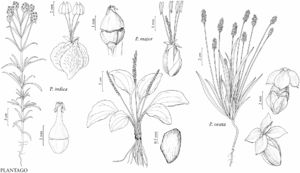Plantago indica
Syst. Nat., ed. 10, 2: 896. 1759.
Annuals; roots taproots, slender. Stems 100–350 mm, freely branched. Leaves cauline, opposite, 60–80 × 1–3 mm; blade linear to linear-lanceolate, margins entire or toothed, veins conspicuous or not, surfaces hairy. Scapes 100–650 mm, hairy. Spikes greenish or brownish, (50–)150–250 mm, densely flowered, eglandular; bracts proximal strongly differing from distal, ovate, 2–5(–7) mm, length 1–1.5 times sepals, proximal bracts: apex acute. Flowers: sepals 2–3 mm; corolla radially symmetric, lobes reflexed, 2–4 mm, base obtuse; stamens 4. Seeds 2, 2–2.5 mm. 2n = 12.
Phenology: Flowering late summer–fall.
Habitat: Roadsides, railroads, sandy shorelines.
Elevation: 0–200 m.
Distribution
Introduced; B.C., Man., Ont., Que., Calif., Conn., Del., Ill., Ind., Iowa, Maine, Mass., Mich., Minn., Mo., N.H., N.J., N.Y., N.C., Ohio, Oreg., Pa., Vt., Va., Wash., Wis., Eurasia.
Discussion
While considering the proposal made by W. L. Applequist (2006) to reject Plantago psyllium, the Nomenclature Committee for Vascular Plants also decided that P. indica is a legitimate name (R. K. Brummitt 2009). A. B. Doweld and A. Shipunov (2017) published a proposal to reject P. indica in favor of P. arenaria. That proposal was not accepted.
Selected References
None.
